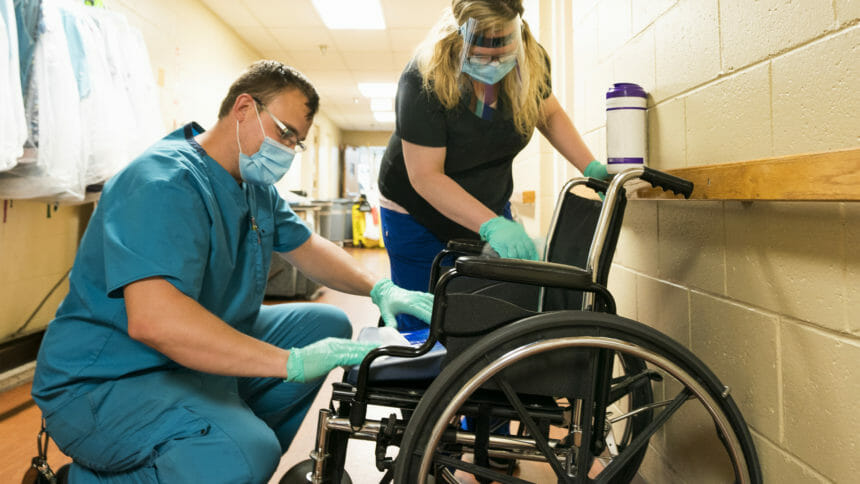
As many providers begin the new year juggling tight budgets, managing infection prevention remains a top-line consideration. With the critical shortages in the nursing home workforce today, there may not be a more important hire than the now-mandatory infection preventionist. Key infection control experts offer advice on finding, training and keeping an IP who will be in it for the long haul.
1. Experts note there are no roadmaps for choosing an ideal candidate. But the hunt should begin with a management team and administrator who fully understand what the position entails, said Mary Madison, RN, RAC-CT, CDP, clinical consultant, LTC/ senior living, Briggs Healthcare.
“Other than education and certifications, any candidate should have a passion to properly do the job,” she added. The Centers for Medicare & Medicaid Services says an ideal IP candidate has previous experience as a nurse, medical technologist, microbiologist, epidemiologist, pharmacist or a physician, according to Caryn Arnold, MBA, RN, CNOR, Medline’s medical science liaison.
Deborah Burdsall, PhD RN-BC, CIC, a consultant for the Association of Practitioners in Infection Control and Epidemiology, has also seen former public health workers and respiratory, occupational and physical therapists make strong candidates.
2. The kinds and depth of qualifications or achievements should never be overlooked in any IP candidate.
In short, there’s far more to the job than many realize. Given the heavy load, Madison advises choosing candidates with prior full-time experience in infection prevention and control, surveillance, education, monitoring, data collection and analysis. Madison also encourages administrators to have at least a part-time “back-up IP who can assist when the load is heavier.”
3. Hiring from within can facilitate trust and better morale among staff. But casting a wider net, of course, can often yield the most experienced and qualified candidate.
Appointing an ADON or wound care nurse from within is a viable measure, said Gisele Valentine, BSN, RN, MBA, CWS, senior director of clinical affairs at Essity. “Hiring the best candidate that will fulfill the organization’s goals is always a primary intention,” Valentine said. “Hiring within is great to show the organization’s commitment to an employee’s professional career growth goals.”
“Start with your employees,” advised Burdsall. “You know their work history and they have established relationships. And don’t forget to focus on all shifts. There may be an evening or night shift CNA who is a nurse or physician in another country who may be perfect for the job.”
“I’m a firm believer in looking within, at least initially,” said Madison. “There are a lot of talented and passionate individuals in our own facilities. An internal candidate brings a lot of good things to the position – knowledge of the facility’s policies and procedures, knowledge of existing staff and residents, and showing other staff members that their expertise is appreciated and rewarded.”
Arnold urges taking as broad of a look as possible, taking all vantage points into consideration.
“Outside hires are always a viable option when considering new talent, as they come with fresh perspective and ideas, but I also believe there’s value in looking internally at the extensive talent they already have,” she said. “With turnover rates continuing to challenge facilities, focusing on your employees’ career paths can help give your employees opportunities to grow and learn in new roles.”
4. As critical as checking candidate qualifications and talent/experience searches can be, hiring managers are strongly encouraged to ensure that thorough and vetted training is in place before the IP candidate’s first day on the job.
“An essential place to start is the initial training and subsequent annual competency training of the organization’s ‘best practices’ and organizational wound infection guidelines,” said Valentine. She also encourages ensuring the new IP thoroughly understands the real economic costs of treating wounds.
All new IP hires should take training courses in infection prevention as soon as possible, advises Karl Seagren, senior product consultant, Direct Supply. Other sources include AHCA’s Infection Prevention Control Officer online training course and the CDC’s free online infection prevention and control training program for nursing home IPs. Seagren also advised IP candidates to become APIC members.
Infection preventionist mistakes to avoid
- Putting the IP’s office in the basement. Their role is too critical.
- Failing to understand that having an educated and engaged IP can save money — and preserve reputation.
- Assuming that individuals who have not spoken up are not interested in the job.



